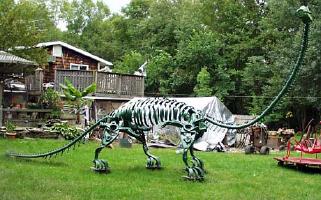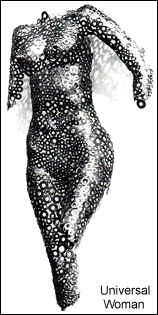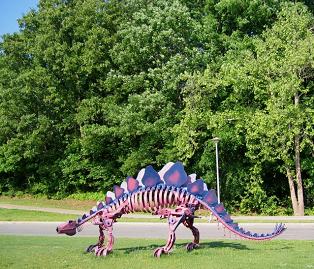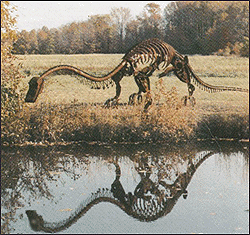 JIM GARY - King of the Museums
JIM GARY - King of the Museums
 Interview
With Jim Gary, Part II
Interview
With Jim Gary, Part II
Jim Gary's home studio in Bruce Springsteen country (Red Bank, NJ) is
called 'Iron Butterfly.' I was able to visit during the Psychic Panorama week at Asbury Park's restoration and celebration* during my East Coast public speaking tour that year. At that time we discussed some of the unique techniques employed for creation of his monumental art. Gary explained to me how he mixes metals people say can't be combined. He mentioned his conversation with Carlos Castaneda, a fan of his who came to one of the shows and stayed for the reception. As it appears, Castaneda is an admirer of Gary's phenomenal metal work, both as art and a form of alchemy. There is no question Gary's art is timeless.
Continued from Part I
DKD Well, if you can do that, what can't you do?
JG I've done it - the torso, the abstracts, whatever, and I'm saying, "What do you want me to do?" My torsos have won every show I've put them in; the abstracts have won; the animals have won.
DKD What do you think of someone like Henry Moore?
JG I love his work. The vertebrae series especially.
DKD Would you feel comfortable with, or even want to do, something like that yourself?
JG No, he's done that - that's great. You can recognize Henry Moore. There are only a few people in this country you can see and say, 'That's a Henry Moore.' Or, 'That's a Caulder.' You know, 'That's an Oldenberg,' but the rest of them are just a mixture of everybody else and there's not many people where you could just sit down, put a sculpture up and know who's it is. Only a few of 'em have fingerprints that don't change, that are just there. And that's what I really wanted my own things to be - to have their own set of fingerprints, so anyone would know, 'That's a Gary.' They wouldn't mistake my work for anyone else's. Before I was 'doing things,' everything I did was shades of everybody else. But you know different things, you try to do something, you try to keep going, and you try to keep better than everybody else. And so, I was always searching for things and I'd find something I thought was good, and I'd look.
I traveled around the country to see who was doing this and that, you know, and you always come up with somebody who's doing something like you're doing. Then I finally said, 'I'd better get up on dinosaurs - there's nobody doing this.' And so I said okay. I finally got something better.
All my nudes and torsos, they were something that was different, but they were still nudes and torsos. Nobody's ever taken the dinosaurs and built them from the bones out - they always go the other route: the skin and the appearance of what they already look like. If I used bones to make my dinosaurs, I'd be just another scientist, but I'm not doing that. I'm taking other components and making you think they're bones. I instill an attitude into the sculpture because the parts don't give you attitude; they're just there, you know. But I take parts and make you think you're looking at what you're looking at - and you are.
It's caused a lot of problems with a lot of people, especially people who ?'now art,' as we say; where do they put the line; where do they define what is real and what is not, say what is abstract and what is realism. Am I abstract or am I realism?
But you're looking at a dinosaur. But is it abstract or is it real? And it's caused so many problems with this structured society; how do they classify me? And it's just boiled down to that. They had to make a choice, because they can't throw me out because I'm not either one of those things, just in another category - basically by myself.
And that's one of my problems. When you're so different than anybody else. You can look at these things, and looking at them first hand you think somebody made them to look like bones. But I did not make these pieces; they were there and I took them and make you think they were bones. So, this is a little battle in the art scene. Because they look at it as 'just assembling bones' and I'm not doing that. I got accepted into the Art Society (finally) WITHOUT a classification.
JG Manager They can't put you into a box.
JG It's just a weird situation because it took them an extra month before they could even figure out what they were going to do with me. Starchy type people who 'stick to their guns'; but, it's not realism, but yet again, you're looking at this thing and it's real - you can see it. It's not an abstract form, but yet it is an abstract because it's not real bones, you see.

DKD What do you do to get that 'feel'? Do you use clay or toys, water colour art first, or something else to set up the feel of it all before you begin work on a life size model of one of these fabulous dinosaurs of yours?
JG No, it's all in my mind, that's all. Yes, I don't draw any of the things out. You know I was telling my manager the other day that I really don't know how I see these things. I can stand in my mind: I'm standing here looking at this side, but I also can see it in the other perspective, from the other direction. Something I'm working on - I can see this side of it as well as from where I'm standing, all of it at one time.
Manager Well, this is very beautiful any way. Everybody is going to see something different from his or her own perspective anyway. I mean that the story that you write about him is going to be very different than an art historian would be doing. But, it's interesting to see and to look at it in all the ways there are to view it.
JG It took a long time because I hid these away for a few years because they get so far ahead of the time that everybody's laughing at them. What do you do with a dinosaur? Nobody had ever seen one outside of a museum.
DKD You've exhibited at the Boston Museum, in Los Angeles, all over the world. How do you become so well known to people - how do people respond? Are they really cognizant of this whole presentation you have composed?
JG Well, figures don't lie. I can go back here in terms of the number of people who come to see these shows. Take Carnegie in Pittsburgh: the normal amount of people who would visit there in three months time is 10,000. When we were there we drew a crowd of 74,000 in six weeks time. Indianapolis was similar - we got a crowd of 117,000 in six weeks, while the rest of the time the usual attendance is about 10,000 is six months. In Los Angeles there were roughly around 500,000 people who came to see the dinosaur art in twelve weeks. Their annual intake for one year is only 850,000 people. That wasn't so bad for our record and the history of the exhibit. Memphis drew in 74,000 people in ten weeks, which was the biggest crowd they've ever had. And so on. Japan was a great experience. Their response to my work is that they will be building a part soon and they have sent me the plans of the whole park they want to build there; they were so interested in my work they want me to do several life-size dinosaur sculptures for their project.
DKD Your art is so fascinating (as well as scientifically precise) that it is very hard for me to view it and just wonder how in the world you can envision these creations with such a perfect eye. Do you believe in reincarnation? Do you think you lived before and perhaps contacted the real article in person? What devices do you use in order to manipulate these huge parts - levers and pulleys? How can you work with something that gigantic?
JG I have my own way of doing it - levers, as you say. And I've got things that move things for me. Mainly, simply with boards, that's all. And one of the things too, is that I look at most people working with metals who don't have control over metal. The metals control them and that's not where it's at. You have got to be able to do anything; you've got to be able to control anything to do it effectively. The right amount of heat, the right amount of pressure. It's a matter of pushing the right button, or whatever you want to say. And that's the one thing I look at mostly with my work. I just look at something and I know I have to have so much heat in order to bend this, or so much leverage to manage this, and so it goes from there.
At this point, Jim Gary leaves in order to attend a meeting upstairs with the Academy of Sciences personnel. His manager told me Australia, Sweden and France are all interested in Gary''s work. We were able to join up again afterward and watch him put a dinosaur sculpture together in the large courtyard just before the live music provided by THE DINOSAURS began. Catch the interview with DINOSAUR Peter Albin, founding member of Big Brother & The Holding Company.
The exhibit has traveled internationally for decades. Dinosaurs represented, one as large as 60 feet long and 18 feet tall, include Brontosaurus, Stegosaurus, Triceratops, and Tyrannosaurus. Read the brief review of Jim Gary's road less traveled below. Fantastic genius! He will be sorely missed.

NEW JERSEY'S MUSEUM KING
"His show really got us rolling," said Russell Daws, director of education, Academy of Natural Sciences in Philadelphia. In fact, monies and ideas drawn from the 'Twentieth-Century Dinosaur' exhibit helped the Academy to mount the largest and most ambitious permanent exhibition - 'Discovering Dinosaurs: A compelling new look at an ancient subject' - ever undertaken to revitalize this museum.
 His 1982 show at the Memphis Pink Palace Museum in Tennessee drew the largest number of visitors in the museum's 53 years of existence: more than 70,000 in ten weeks, according to Director Douglas R. Noble.
His 1982 show at the Memphis Pink Palace Museum in Tennessee drew the largest number of visitors in the museum's 53 years of existence: more than 70,000 in ten weeks, according to Director Douglas R. Noble.
Hundreds of thousands of viewers attended his show in the People's Museum, Tokyo, Japan, in the spring of 1984. The Los Angeles County Museum of Natural History boasted more than 500,000 spectators in twelve weeks due to the infinite magnetism of his Twentieth Century Dinosaurs.
"It certainly proved to be one if not the most popular special exhibits we have ever had," wrote Leon G. Arnold, assistant director of the Los Angeles County Museum.
"The Jim Gary exhibit was very successful with about a 300-percent increase over the same time one year previous," wrote John B. Clark, director of the Bruce Museum, Greenwich, Connecticut, in 1979. The media "loved the show because it is very photogenic. It has tremendous grass roots appeal."
The list of museums that have successfully mounted Jim Gary's compelling metal-sculptures show is increasing, and Gary, a black artist from Red Bank, N.J., insists upon using his own system to deal with the art world.
His 'system' is to defy all established trails to one-man exhibitions in major museums. Instead of the typical representation by a gallery, Gary sends to museum directors a motley packet of photographs of his work, published clippings and tearsheets, previous exhibit data, and a resume that is too overloaded with credits for even the most liberal of resume standards. His portfolio runneth over....
Gary's sculptures attract "small children to their grandparents, from artists to our own research paleontologists," said Timothy Parks, assistant director of the Carnegie Museum of Natural History, Carnegie Institute, Pittsburgh, where Gary brought his artwork in 1982.
"Floridians are still talking about Jim Gary," wrote Walter L. Smith, president of Florida A&M University, Tallahassee, in August 1978. "Without a doubt,
(Gary's) exhibition... was one if the most creative and popular artistic acts ever to hit the city of Tallahassee. We estimate that 212,000 people saw the work during my Inauguration Weekend". Appearances by (Gary) on evening and night TV news shows on WECA and CBS-affiliate WCTV-TV reached an additional 173,000 people. "It was truly an entertaining, informative and educational experience for all of us."
But the curator in Trenton preferred than an artist be handled through a gallery. A burr in Gary's system? Says Gary: New Jersey missed its chance.
Incongruous as well with the art world is the sculpture itself - huge anatomically-correct dinosaurs of all species that push the philosophy of objet trouve to the limit. Gary's major medium consists of oil pans, brake shoes, rocker arms, push rods, universal joints, leaf springs, and other discarded car parts right from the auto-graveyards of Monmouth County, New Jersey.
Save Gary's playful use of automobile paint (a shocking-pink Pteranodon, a silver Dimetrodon, and a burgundy Tyrannosaurus, for examples), the sculptures swing from art to science to technology like a high-powered pendulum. Museums of natural history and museums of art mount Jim Gary's show, a lot which falls to few artists. Gary's show, for instance, opened the Charleston Museum of Art in South Carolina. Also, "it is enormously difficult for history/natural history museums to obtain high-quality, three-dimensional, traveling exhibits. Although Twentieth-/Century Dinosaurs is not a natural history exhibit in the strictest sense, it is one of the finest traveling displays I have seen in my ten years as a museum director," wrote Douglas Noble in 1982. "Any museum with an adequate marketing plan and promotion will captivate the imagination of the entire community and can fully expect the same success we experienced."
Twentieth-Century Dinosaurs bring life and motion to what may be a stagnant museum atmosphere with their 'personalities.' Their facial expressions range from ferocious to bewildered, from daffy to determined. In these traits, they are undeniably the offspring of Jim Gary - it's practically genetic.
One can find Gary's art on the pages of science periodicals (National Geographic World, Ranger Rick, The Explorer), trade journals (Welding, Ford Times, U.S. Steel, Auto Week, Games), and art magazines such as N.J. Music & Art, which put Gary's sculpture, 'Red Bird,' on the cover. In a New York Times article, Chester H. Newkirk, director of the Morris Museum, Morristown, N.J., 1979, called Gary's work 'spectacular.' Features about his work were plastered across the Milwaukee daily newspaper when his record-breaking show was at the Milwaukee Public Museum in May 1984.
Museum house organs such as Terra of the Los Angeles County Museum spotlight Gary's celebrated collection of dinosaurs. Museums whose budgets are expanded by corporate sponsors especially enjoy all the bonfires in the media that
Gary's show ignites.
Not only does Gary provide a flaming exhibit, but the lectures, demonstrations, slide shows, personal appearances on radio and TV, newspaper interviews, and museum-generated related programs add what John Clark noted as 'impact and excitement' to the show.
"People have been calling and coming in with great disappointment to find that (Gary's) sculptures were no longer with us," Clark wrote.
Mildred S. Compton, executive director of The Children's Museum, Indianapolis, wrote in a 1980 letter to Gary:
"As you know, we invited you to have your exhibit here for the winter months as we had declining visitation in this period during the last two years. This year we are pleased that we have had over 116,500 visitors during the period of your exhibition. This has set a record for that period!
(Twentieth-Century Dinosaurs) is the first exhibit which we have had for which we received universally excellent comments from all segments of our visitors.
There was a time - before all the museum-show business - when Jim Gary was actually embarrassed to win all the first-prizes in tri-state art shows.
In a Sea Bright, N.J., outdoor show, Gary had on display a 5' nude torso entitled 'Universal Woman.' Superbly welded nuts-and bolts that could double as flesh, lace, or body-cell clusters attracted the attention of a man in khaki pants and a plaid shirt. The man went to Gary and said of the sculpture, "I wish I'd thought of it."
The man did not like the pedestal on which the torso stood, however, and tried to persuade Gary to change it.
"I'm a stonecutter," the man said. "I know what I'm talking about. Look me up in an art book." The man told Gary his name: Jacques Lipchitz. Lipchitz died the following year.
Rube Goldberg awarded Gary the 'Best-in-Show' prize for the collage, 'Signs of the Times,' in Atlantic City, 1966.

"In another show I thought Donald DeLue would take first prize, especially considering how well-known DeLue's sculpture is," Gary said. "When the judges called my name for first prize, I was almost too embarrassed to accept it."
While the world expects artists to be as flamboyant as Salvatore Dali, Gary can be reserved and self-effacing. He usually wears jeans and t-shirts to which Twentieth-Century Dinosaurs decals have been applied. Under duress, Gary will wear a tie, but only ties with little dinosaurs on them. When photographed with his sculpture or called upon to take a public bow, Gary said he feels 'like a turkey.'
Moreover, Gary does not want to be known as a black artist, and often he will turn down ethnic-group programs.
"I don't do ethnic art," Gary said. "My work has no bearing on my being black. My sculpture is good in all colors." Literally.
Gary's sculptures and traveling exhibition are flamboyant even if he is not. His Freehold High School art teacher in the 1960s gave him a failing grade in art because, Gary said, "She did not appreciate my green rabbits and purple spiders and other odd color schemes." That green rabbits would evolve into a green brontosaurus of enormous charm and popularity was not predicted by the art teacher. Gary sloughs off the issue with an ease born of strong belief in his work.
"Remember that birds are brightly colored," he said. Gary's sculptures 'prehistoric and contemporary' are as colorful and surprising a spectacle as Nature herself, and viewers can't get enough of them.
Many of the articles and TV shows about Gary such as 'Real People' and 'Prime Time' emphasize that he 'recycles' old car parts in this era of diminishing resources. In truth, just as Picasso created 'Head of a Bull' with a bicycle seat and handlebars, so does Gary make an immediate history of discards. While the pieces Gary uses in his sculptures are recognizable, he wants the viewer to see first the sculpture, first the art.
"At my Charleston Museum show, a woman asked me if she could purchase a 'dinosaur kit' for her grandson to assemble," Gary said. The woman had no idea that Gary's complicated creations began not with Krazy Glue and a set of directions, but with predatorial prowls for pieces 'that fit my design,' as Gary put it.
Despite the magnitude of appreciation Gary's work gathers, why is there always an enchanted viewer who simply cannot place the work in its proper category?
"Some people will always ask me, 'What do you call this?' 'Sculpture,' I say. Then they ask, 'Do you also do art?' It's amazing to hear things like this. I try not to look surprised," Gary said.
Instead, Gary looks at his busy schedule. Beginning in the fall of 1984, Twentieth-Century Dinosaurs go to the Anniston Museum of Natural History, Alabama, then to the Field Museum in Chicago, and in November, to a four-month exhibit at the Boston Museum of Arts and Sciences. On the horizon for spring 1985 is a show in San Francisco, among other shows.
For all his breaking of rules and hybrid work, Gary is a museum king, his royal entourage part beautiful, part daft, and totally art.


Dinosaur art by Jim Gary may be found in THE NEW BOOK OF KNOWLEDGE (pgs 254-255) and in Walt Disney's WONDERFUL WORLD OF KNOWLEDGE YEARBOOK 1985
(page 84).
You can see these magnificent art forms in the feature motion picture HOWARD THE DUCK, from George Lucas.
* Psychic Panorama Week at The Berkeley-Carteret Hotel
Ocean Avenue
Asbury Park, NJ
Dinotopia: The Fantastical Art of James Gurney
Inspired by archaeology, lost civilizations, and the art of illustration, Gurney’s Dinotopia is an extraordinary place where humans and dinosaurs live in harmony in a society that has its own language and alphabet. Gurney’s stories and art fuse fantasy with realism and scientific accuracy.
Dinosaur Boulevard Mural from Dinotopia
Dinosaur Boulevard by James Gurney from his book Dinotopia

Colour Us Inn,
Innholders' Company,
It's All In the Sauce,
Jupiter Table,
Mercury Table,
shrmx,
vittles
Top |
Abramelin | Alchemy | Ancient Oracle | Articles | Artists ~ Rock & Roll | Astrology | Astroscape | Aura | Babylon 5 | Beat | beatles | blog | Breathe | Bus | Candles | Colour Waves | Constantine | Deva | Divination | Dowser | Early Heraldry | email | FAQ | Gladiator-Champion-Fighter | Haight-Ashbury | Heartwarmer * Bread & Roses | Hip | Hobbit Dowser - Nyll Greenwood | Hogwarts | House System * Sacred Tarot | Internal Spectrum | Lab | Mandala | Mask-Who Was That Masked Man? | Masked World | Matrix | Meditation Index | Middle-earth Inn | Mirror | Mountain | Mystique | Neutrals | Number 1-9 | 11-22-33 | Palm | Parapsychology |
Phoenix |
Pix | Quiz | Sacred Place | Shrine | Site |
Sixth Sense |
Son of Spooky | Space | Star Chart (by Zodiac) Listing | Star Trek | Star Wars | Still Zone |
Stonehenge | Tao | Transcription breaks | Transform | Tutoring |
Twitter | Unicorn | Unknown Museum |
Unnumbered Tarot | Us | US Time
| Valentine | Vote Star Charts | Wall | Wands | Whale | Wizard | Your Elf | Zone
